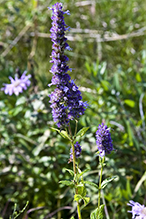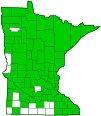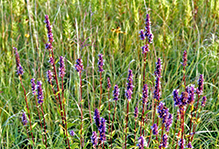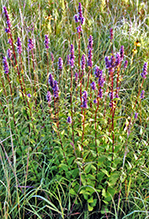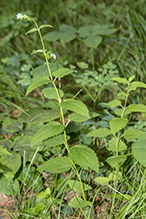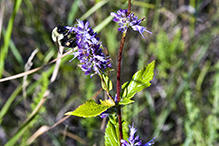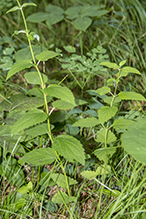blue giant hyssop
(Agastache foeniculum)
Conservation • Description • Habitat • Ecology • Use • Distribution • Taxonomy
Conservation Status |
|
|||||||
| IUCN Red List | not listed |
|||||||
| NatureServe | NNR - Unranked SNR - Unranked |
|||||||
| Minnesota | not listed |
|||||||
Description |
||
Blue giant hyssop is a 24″ to 36″ tall, erect, perennial forb that rises from a taproot. The stems are erect, square, and occasionally branched above the middle. They are usually hairless, sometimes slightly hairy. The leaves are opposite, egg-shaped to triangular egg-shaped or rhombic egg-shaped, up to 3½″ long, and up to 2″ wide. They are on leaf stalks that are no more than ⅝″ long. The leaf blades are broadly angled or squared off at the base and tapered to a point at the tip with straight or concave sides along the tip. The upper leaf surface is dull green and hairless. The lower surface is whitish due to a dense covering of microscopic, fine hairs. The hairs are barely discernible when using a hand lens with 10x magnification. The margins are coarsely toothed with sharp, forward-pointing teeth. The leaves emit a strong, anise-like odor when crushed. The inflorescence is a dense spike at the end of the stems and branches. The spikes are up to 6″ long, ¾″ to 1″ wide including the corollas, and are often interrupted at the base. The flowers are arranged in dense whorls that are subtended by hairless, broadly egg-shaped, abruptly tapered, inconspicuous bracts. The individual flowers are about ½″ long. There are 5 dull blue-violet sepals fused onto a ¼″ to ⅜″ long calyx tube with 5 lance triangular-shaped lobes. The calyx tube is minutely hairy when in flower. There are 5 petals fused into a funnel-shaped corolla tube with a 2-lobed upper lip and a 3-lobed lower lip. The corolla is blue and extends well beyond the calyx. There are 4 stamens with purple anthers that protrude well beyond the corolla. After the corollas drop off, the spike that remains is blue-violet, not green or whitish. There is no floral scent. The fruit is a more or less 3-sided nutlet. |
||
Height |
||
24″ to 36″ |
||
Flower Color |
||
Blue |
||
Similar Species |
||
Purple giant hyssop (Agastache scrophulariifolia) is a much taller plant, 36″ to 60″ in height at maturity. The underside of the leaves are green, not white. The calyx is green and hairless. The individual flowers are white or pale pink to purple. The spike that remains after the flowers have dropped is green or whitish, not purple. |
||
Habitat |
||
Dry to moderate moisture. Upland woods and prairies. Full or partial sun. |
||
Ecology |
||
Flowering |
||
July to August |
||
Pests and Diseases |
||
|
||
Use |
||
|
||
Distribution |
||||
|
Sources |
|||
| 2/22/2023 | ||||
Nativity |
||||
Native |
||||
Occurrence |
||||
Common |
||||
Taxonomy |
|||
| Kingdom | Plantae (Plants) | ||
| Division | Tracheophyta (Vascular Plants) | ||
| Subdivision | Spermatophytina (Seed Plants) | ||
| Class | Magnoliopsida (Dicots) | ||
Order |
Lamiales (Mints, Plantains, Olives, and Allies) | ||
Family |
Lamiaceae (Mint) | ||
| Subfamily | Nepetoideae | ||
| Tribe | Mentheae | ||
Subtribe |
Nepetinae (catmints, ground ivies, and hyssops) | ||
| Genus | Agastache (hyssops) | ||
Synonyms |
|||
| Agastache anethiodora | |||
Common Names |
|||
anise hyssop anise-mint blue giant hyssop blue giant-hyssop fragrant giant hyssop lavender giant hyssop licorice-mint |
|||
Glossary
Bract
Modified leaf at the base of a flower stalk, flower cluster, or inflorescence.
Calyx
The group of outer floral leaves (sepals) below the petals, occasionally forming a tube.
Corolla
A collective name for all of the petals of a flower.

Slideshows |
||

Visitor Videos |
|||
Share your video of this plant. |
|||
| This button not working for you? Simply email us at info@MinnesotaSeasons.com. Attach a video, a YouTube link, or a cloud storage link. |
|||
Other Videos |
|||

Visitor Sightings |
|||||
Report a sighting of this plant. |
|||||
| This button not working for you? Simply email us at info@MinnesotaSeasons.com. Be sure to include a location. |
|||||
|
|||||
MinnesotaSeasons.com Sightings |
|||||
Badoura Jack Pine Woodland SNA Carver Highlands WMA, South Unit Charles A. Lindbergh State Park Lake Alexander Woods SNA, South Unit Minnesota Valley NWR, Rapids Lake Unit Northern Tallgrass Prairie NWR, Rengstorf Unit Pembina Trail Preserve SNA, Crookston Prairie Unit Pembina Trail Preserve SNA, Pembina Trail Unit Sand Prairie Wildlife Management and Environmental Education Area |
|||||

|
Created: Last Updated: © MinnesotaSeasons.com. All rights reserved. |
